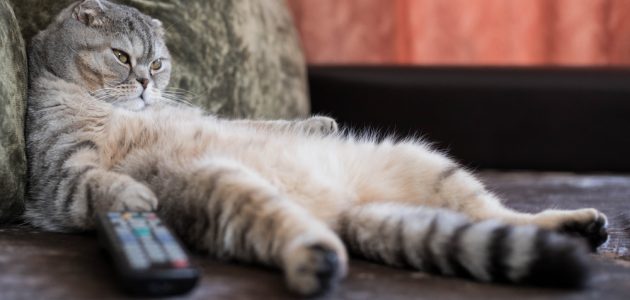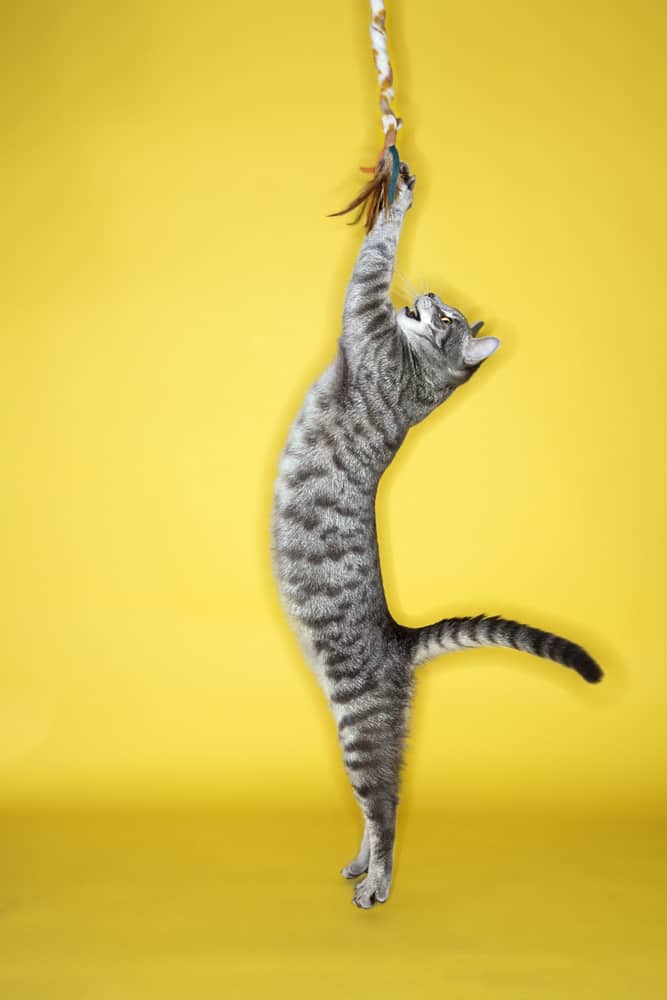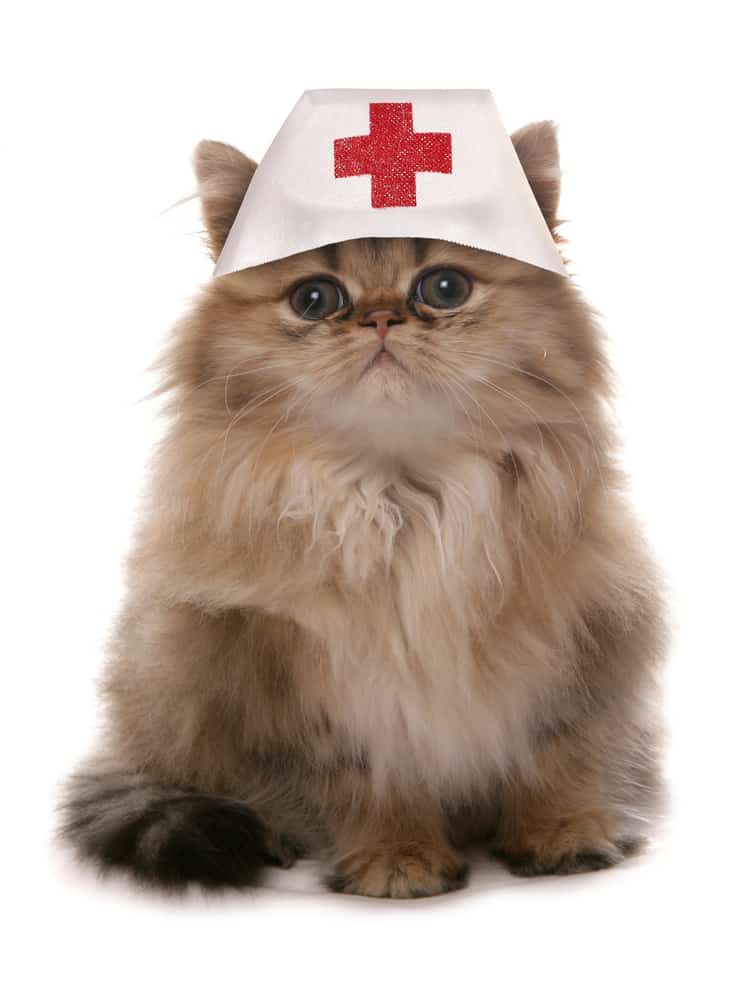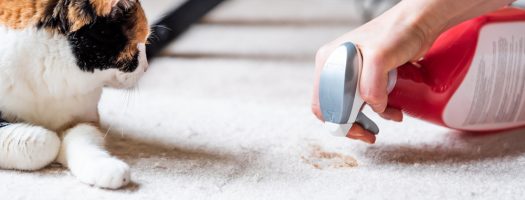The Easy but Not Fast Guide to Making Your Cat Lose Weight

Just like their round-eared servants, cats in the developed world face an uphill battle against excessive weight gain. The Association for Pet Obesity Prevention reports that nearly 60% of cats in the US have a little – or more than a little – extra paunch.
But the good news is that it’s not the end of the world. They might be unwilling to do it themselves, but with your help and a little bit of diet and exercise, even the chunkiest kitty can be svelte once again.
A Fat Cat Is Not a Happy Cat
Sorry, Garfield. Despite the internet being fit to burst with videos and memes of rotund felines scurrying about, the data suggests that a willing lack of dietary control constitutes negligence at best, and may even dance on the edge of outright abuse.
Overweight cats are more vulnerable to a series of maladies ranging from heart disease to cancer. In terminal cases, several conditions can pile up until it simply becomes too much to bear. A slow gauntlet of overheating, joint pain, and organ failure that comes to an ignoble head only after months of agony.
Even if they aren’t crushed under their own weight, their quality of life can still be hampered by a sharp decline in physical endurance, breathing difficulties, and in some cases, depression. You may love your ball of fluff despite, or even because of their image, but the true severity of the subject remains. Your cat’s happiness and longevity lie in your hands.
If your cat is overweight, this shouldn’t be taken as a personal condemnation. Thin education, a tone-deaf portrayal by popular media, and even misinformation spread by pet food producers all contribute to the current state of affairs. If you want to beat the curve and help your cat shed their extra weight, consider the following.
Understanding the Process
The problem can be approached from the same angle that health experts use to help humans. At the most basic level, weight gain is caused by an imbalance between calories consumed and calories lost.
A greater portion of the extra calories that your pet doesn’t use is stored within fat cells that they developed as kittens. Unfortunately, fat cells do not disappear, they merely shrink. Cats that were chunky in their early years will have a harder time losing weight as well as maintaining a healthy weight after achieving it.
It is best then, to start early and remain firm with your efforts to trim your friend’s tummy.
How Much Should My Cat Eat?
Sedentary cats generally use 20 calories per pound, while more active cats use 35. It is recommended to only remove up to 2 pounds worth of their caloric expenditure to ensure that they don’t lose weight too quickly, which can come with its own host of issues.
One cup of dry cat food usually has around 400 calories, so an average 10-pound cat should eat about half a cup per day, though this might be as high as one cup of some brands, so be sure to check the bag.
If your cat eats wet food, they should have somewhere around 3 3-ounce cans of food each day to maintain a healthy weight—but even moreso than dry food, this varies by brand, so calculating the calories for yourself is best.
How Much Should My Cat Weigh?
The general consensus sticks a pin on an ideal weight of 8 through 10 pounds for the average house cat, though this number alongside caloric intake and usage can vary depending on breed. If you are at all uncertain about where your cat should stand, pay your local veterinarian a visit, especially if you’re the guardian of a less common breed.
How Do I Tell if My Cat Is Overweight?
Should a checkup be outside of your means, or if you’re interested in keeping tabs on your pet between visits, you can get a quick gauge of your cat’s condition by gently squishing them from their backbone forward. You should be able to feel their ribs without too much resistance. Additionally, their top profile should reveal a waist figure, but not a rounded shape.
Vets use a similar method of investigation to assign what is known as a Body Condition Score, or BCS. Ratings range from 1/5 to 5/5 in some disciplines with others using a 1/9 to 9/9 scale with 3/5 and 5/9 being considered ideal.
Eating Right
If you’re in the habit of letting your cat nibble throughout the day, you can start helping them lose weight by restricting their food intake to meals only. Snacking is an imprecise and oftentimes overindulgent practice that can run away before you notice how bad it can get. While you may yearn to spoil your floofball, and they may complain when their stomach starts rumbling, don’t give in. Distract your cat with affection or play. It’s for their own good.
If you can’t take snacks off the menu, you can reduce the amount of food you dispense during meals accordingly. It is imperative, however, that you don’t end up feeding them more junk than nutrient-rich fare. Try to keep the tasty but unhealthy stuff to less than a tenth of their diet.
Avoid Free Feeding
As with snacking, free feeding, leaving an abundant amount of food out for your cat all day, can easily lead to unwanted weight gain. Cats don’t have a concept of “enough” not in the same sense we do. Stress or even boredom can push them to consume past the point of satiety, which can become a habit.
Choose the Right Foods
You should also scrutinize what you feed your cat. Dry foods are often chosen for their low price and sturdy shelf life. As implied by the name though, they have an abysmally low moisture content. This places more pressure on your cat to drink, which as creatures that evolved to absorb most of their water from food, are generally reluctant to do.
One needn’t look further than undigested chunks in their stool or throw up to see the implications on their digestive system. Even worse, many dry foods have excessive carbohydrates which makes it more difficult for your cat to lose weight.
Try Multiple Small Meals
After determining how many calories your cat needs per day, the recommendation is to ration it between 2 or 5 feedings. Smaller, more frequent meals might make your cat feel full longer, and curb begging.
Transition Carefully
If you do change up your cat’s diet or feeding regimen, take care that you do so gradually, mixing the new food with the old for the first few feedings until it is completely replaced. If you’re transitioning from free-feeding to meals, reduce the amount you usually put out and offer the rest at scheduled times until you can do away with the stockpile.
Take note that if you’ve been drastically overfeeding your cat, the same principle applies. Reduce offerings slowly until a healthy diet is achieved.
Get Those Paws Moving!

You could theoretically reduce your cat’s weight based on diet alone, but it’s not the best of ideas. In addition to being more susceptible to obesity-related issues than their active counterparts, sedentary cats can suffer under a lack of physical and mental stimulation. They may develop destructive behaviors that lead to property damage.
With no way to sit you down and discuss how frumpy they are, ruining the couch may be the only way for them to vent when you don’t play with them.
Meeting this need won’t require too much effort on your part. If you’re too tired to chase your cat around the house, you can browse through ready-made devices on the market from laser pointers to electric mice that can do all the scampering for you. You can even fashion a simple toy out of an old shoelace and sock.
You should aim for a total of 20-30 minutes of playtime throughout the day. It doesn’t need to be all at once, especially if your cat is too unhealthy, or simply too unmotivated to tussle. As long as you’re patient and consistent, an active lifestyle will remain a great ally in your efforts to keep those calories in balance.
More Creative Avenues
If you’re willing and able to take a more unconventional approach, food laced puzzles and toys are available for purchase. The most simple are balls that need to be batted around before they dispense their goods. Toys can work double duty by providing a bit of exercise and fun to your kitty’s life. Don’t rely on them as your cat’s only source of activity, though.
If you’ve sworn off dry food, you’ll have to look a little harder for wet food compatible puzzles, but they do exist, mostly in stationary form. You may need to show your cat how some of the more complex ones work.
Turned off by pet food companies? You can take your cat’s nutrition into your own hands, though the effort may prove a bit daunting at first. The benefits of eliminating processed foods from nebulous sources can provide peace of mind, and has been seen to positively affect weight loss with proper portions. It also has the benefit of being very palatable; your “cooking” will likely draw more satisfied meows than the big brands.
You do, however, need to make sure that you find a guide from a reputable source and follow it religiously, lest you do more harm than good. The writings of Dr. Lisa A. Pierson of Catinfo.org fulfill such conditions and can be easily accessed.
Medical Concerns

Should all of the above fail despite your best efforts, you may wish to consider the possibility of your cat suffering from an issue more insidious than overeating, though instances are rare. Among the culprits could be Cushing’s Syndrome, a parasitic infection, or feline infectious peritonitis, the latter of which has a distressingly high mortality rate with no known cure.
Let the Diet Begin
More commonly the problem isn’t that serious, but you should be careful if your cat fails to lose weight despite your best efforts. If your cat has gained weight rapidly, or exhibits severe uncharacteristic behavior next to their weight problems, see a veterinarian with all due speed. Otherwise, pay a little bit more attention to their diet and exercise and Garfield will start shedding off those lasagna-induced pounds in no time.




